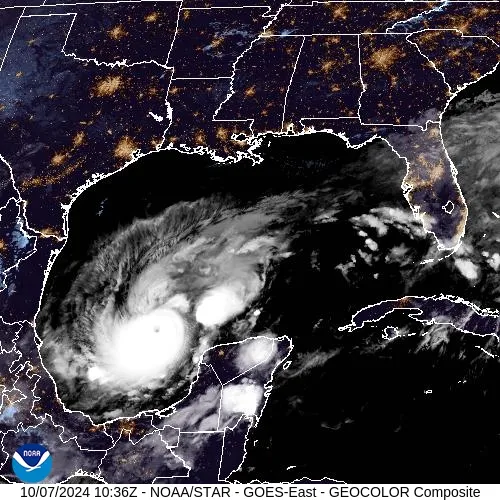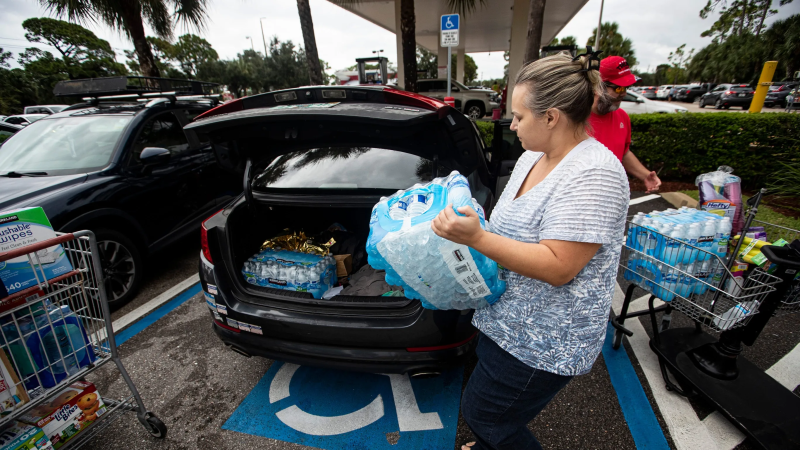Milton strengthens again, now a Cat 4 hurricane aiming at Florida: Live updates
Hurricane Milton strengthened to a major Category 4 storm early Monday, driving sustained winds of 155 mph as it rolled across the Gulf of Mexico bound for what could be a devastating crash along Florida's already storm-battered western coast sometime Wednesday.
The storm has rapidly intensified, strengthening from Category 2 to 4 in a couple hours, and was forecast to reach Category 5 status later Monday. The National Hurricane Center has issued hurricane watches across portions of Florida and warned that parts of the state could be overwhelmed by life-threatening storm surge, flooding rain and damaging winds.
Milton is forecast to remain an "extremely dangerous" hurricane for the next couple of days. A Category 5 hurricane features sustained winds greater than 155 mph. Some weakening is forecast before the hurricane reaches the coast, but Milton "is still likely to be a large and powerful hurricane at landfall in Florida," hurricane center specialist Jack Beven wrote in an advisory.
Rainfall is expected to total 5-10 inches in some areas of the state that were saturated even before Hurricane Helene smashed ashore less than two weeks ago. Isolated communities could see 15 inches, the hurricane center said in an advisory. Some areas will be slammed with heavy rainfall well ahead of Milton's arrival, likely later on Tuesday through Wednesday night, the advisory said.
What could be a deadly storm surge of 8-12 feet is possible for Tampa an other coastal communities.
"The track guidance is in good agreement that the hurricane will cross the Florida Peninsula, but there remains significant differences in both the location and timing of landfall," Beven wrote.
Hurricane Milton tracker:Follow projected path of Category 3 storm expected to hit Florida
Developments:
∎ Milton was centered 720 miles west-southwest of Tampa early Monday, moving east-southeast at 9 mph.
∎ Tampa Internatinal Airport will suspend flight operations at 9 a.m. Tuesday and "reopen when safe to do so." The airport is not a shelter for people or vehicles, authorities said.

After Helene, bracing for Milton: 'We're just exhausted'
David Green was expecting to meet Monday with an electrician for a damage estimate on his home, which Hurricane Helene flooded with 3-and-a-half feet of water. Now, for the second time in less than two weeks, he’s again fortifying his home – this time for Hurricane Milton. Green and his wife live on St. Pete Beach, which along with Tampa Bay and surrounding coastal communities, is expected to receive 10-12 feet of storm surge this week.
“We’re just exhausted,” he told USA TODAY.
Green said mounds of debris are still piled up on curbs and buildings are being dug out from under the sand Helene pushed on shore. The 62-year-old said while he’s resigned himself to more flooding, he is worried Milton’s powerful winds could turn the household items into projectiles and cause structural damage.
Early Monday, he rented a truck from Home Depot and packed it with plywood to cover his windows. He plans to wrap up work on the home by Monday night, pack up his fans and dehumidifiers, and wait out the storm at his daughter’s home in Ruskin. In the meantime, he’s going to postpone his appointment with his flood insurance company.
“Everything is already gone and out of the house,” he said. “We just have to shut the power off. Then we wait and see … hopefully we can come back.”
− Christopher Cann
Milton sees 'rapid intensification,' explodes to a Cat 4 in 1 day
Milton grew very strong very fast Monday in what meteorologists call "rapid intensification," which is a dramatic rise in wind speed and a huge drop in barometric pressure in a short amount of time. The phenomenon, which appears to be more common with hurricanes in the Gulf of Mexico in recent years, is typically defined to be a tropical cyclone (whether a tropical storm or hurricane) intensifying by at least 35 mph in a 24-hour period.
Milton more than qualified, exploding from a 60-mph tropical storm Sunday morning to a potent 155-mph Category 4 hurricane − an increase of 95 mph in little more than 24 hours.
Rapid intensification is most likely when a tropical storm or hurricane encounters an "extremely conducive environment," Colorado State University hurricane researcher Phil Klotzbach says. That typically means very warm water, low vertical wind shear and high levels of midlevel moisture.
− Dinah Voyles Pulver and Doyle Rice
From rescue to recovery:The grim task in flood-ravaged western North Carolina
Disney World not taking reservations for Tuesday, Wednesday
Walt Disney World theme parks were still open to the public Monday. Disney, however, was not taking park reservations for Tuesday and Wednesday. Disney had posted a hurricane update on its Disney World weather updates and information page: “Walt Disney World Resort is currently operating under normal conditions. We are closely monitoring the path of the projected storm as we continue to prioritize the safety of our guests and cast members. To ensure you have a magical visit to Walt Disney World Resort, we encourage you to prepare for the local climate and check the weather forecast for Central Florida. Check back for important weather updates."
− Jennifer Sangalang
Mandatory evacuation orders expected Monday
Pinellas, Manatee and Sarasota were among counties expected to announce evacuation orders Monday. Pinellas County, which includes the city of St. Petersburg, was planning to announce mandatory evacuations for 500,000 people in the low-lying areas, Sheriff Bob Gualtieri said Sunday. He urged people to heed evacuation orders after he said too many ignored them for Helene, resulting in 12 deaths in the county and 1,500 emergency calls that went unanswered.
The county already ordered the evacuation of six hospitals, 25 nursing homes and 44 assisted living facilities totaling 6,600 patients, said Cathie Perkins, director of the county's emergency management. School was canceled through Wednesday.
Kevin Guthrie, director of Florida's emergency management division, said the state was preparing for the largest evacuation since Hurricane Irma in 2017, when more than 6 million Floridians were forced to flee their homes.

What does declaring a state of emergency in Florida mean?
Gov. Ron DeSantis has declared a state of emergency for 51 of Florida's 67 counties ahead of Milton. Declaring a state of emergency allows the state and local governments more freedom to coordinate emergency agencies and relax restrictions.
The governor may suspend regulations that would slow emergency response, commandeer private property needed to deal with the emergency, order evacuations and direct or delegate control of the National Guard to help rescue or cleanup operations. DeSantis also could suspend the sale of alcohol, guns, explosives and combustibles, establish emergency housing, limit power services as needed, and impose or allow exceptions to curfews. Read more here.
− C. A. Bridges, USA TODAY NETWORK - Florida
Contributing: Reuters
Disclaimer: The copyright of this article belongs to the original author. Reposting this article is solely for the purpose of information dissemination and does not constitute any investment advice. If there is any infringement, please contact us immediately. We will make corrections or deletions as necessary. Thank you.



